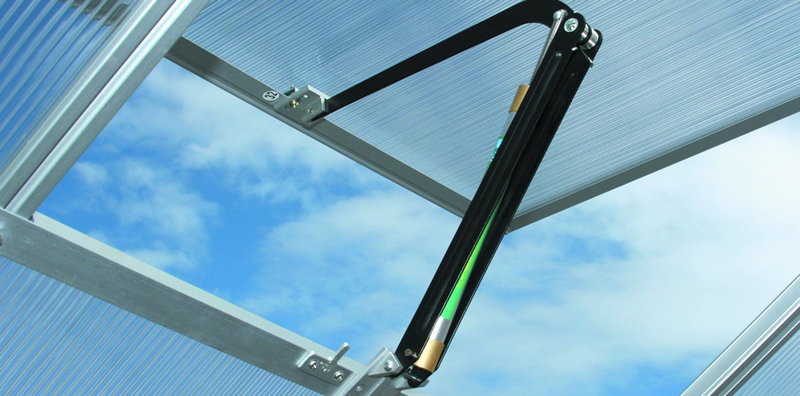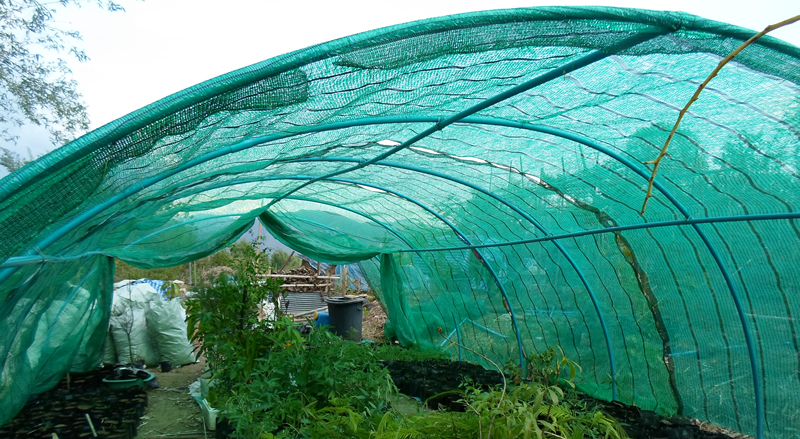Greenhouses Ventilation and Shading - Preparing for Summer
Plants grown in glasshouses, conservatories, plastic greenhouses, polytunnels and garden frames, especially in the summer months, all require adequate shading and ventilation.
Increases in temperature and humidity levels damage the yield and affect the quality of the crops. In many cases, higher temperatures and increased humidity are also a burden on greenhouse workers, which indirectly leads to a decline in output and greenhouse profitability.
Ventilation, either on the walls of the greenhouse or along the structure's rooftop, serves as natural ventilation and hot, internal air is expelled through these air vents.
Due to low levels of internal air pressure and the effect of external winds, cold air is forced into the greenhouse.
When to ventilate and shade your greenhouse
Greenhouses are vulnerable to overheating from spring until autumn. Without protection from heat few plants are likely to survive unharmed when subjected to prolonged high levels of heat and dry atmosphere within a greenhouse or conservatory.
However, with sufficient air circulation, humidity and shading, many plants will tolerate high summer greenhouse or conservatory temperatures in the same way that they survive in the tropics and subtropics where many greenhouse and conservatory plants originate.
The aim of gardeners is to prevent leaf temperature rising to levels at which tissue damage occurs. By September, shading should be reduced gradually, and removed as soon as ventilation alone can control overheating. Blinds and netting used for shading can be deployed on cold winter nights to limit heat losses.
How to ventilate and shade your greenhouse
Leaf temperature is mainly controlled by movement of water through the plant and out through the leaf surfaces in the form of transpiration – this process has a cooling effect on the leaves.
Plants which are dry at the roots or drying out are therefore more at risk than plants which have adequate moisture at the roots.
Air movement is the second important factor, air movement over the leaf surfaces also has a cooling effect.
Ventilation
There are usually three places in a greenhouse in which air can come in and out;
- The door (either single or double doors)
- The roof vents (sometimes running the full length of the ridge and opened either manually or with automated openers)
- The side vents (often louvred)
With larger glasshouses, one square meter of ridge ventilation for each five square metres (20%) of floor area provides the ventilating capacity to give one complete change of air within the greenhouses every two minutes.
Smaller greenhouses have a higher glass to floor area ratio, and should ideally have an even higher percentage of ridge ventilation. Unfortunately, this is seldom provided and amateur greenhouses are very vulnerable to overheating. Extra shading is commonly needed which can cut down on light falling on the plants to a degree which reduces growth and cropping. Thankfully, the door of small greenhouses offers an alternative means of ventilation which partially compensates for lack of roof ventilation. Side ventilation, commonly by louvres, is less effective than roof vents.
For effective ventilation:
- Monitor greenhouse temperature with a maximum-minimum thermometer. If temperatures are allowed to build up (typically more than 27°C/81°F) plant damage can occur
- Be alert for signs that shading and ventilation are required; sun-flag (partial collapse), leaf scorch, desiccation of tender young plants and shoots
- Open all doors and vents on sunny days. These can be left open at night if the temperature remains high
- It is sometimes necessary to temporarily remove panes from glasshouses to assist ventilation in heat waves
- Fit automatic vent openers to ensure roof vents open even when you are not around. However, remember that since they work by the expansion of wax in a cylinder to open the vents, it takes time for the wax to expand. Provide plenty of alternative ventilation (i.e. doors and side vents) to prevent damaging temperatures occuring before the openers respond
- In changeable weather, vents and doors often have to be left partially open to limit sudden increases in temperature. Larger greenhouses may, at high cost, be fitted with automated ventilation and shading
Shading
Opening vents and doors helps to release some of the heat but it is often insufficient and therefore shading is usually required from mid-spring until early autumn.
Unfortunately, shading limits the light plants receive. As plant growth depends on light, only the minimum amount of shading should be used to keep temperatures below about 25-27ºC (77-81ºF). Otherwise, allow as much light in as possible, particularly when growing edible plants such as tomatoes. There is often no need to shade sun-loving plants such as succulents although the greenhouse is more pleasant to be in when shade is provided.
There are various means of shading greenhouses and conservatories:
External blinds: give shade and also provide the maximum cooling effect by preventing the sun's rays from passing through the glass. In periods of dull weather they can be easily drawn up again to allow maximum light on to plants. However, they are likely to be one of the more expensive options (and may interfere with vents).
Internal blinds: do not have the same cooling effect as external blinds since sunlight is allowed to pass through the glass and generates heat. However, they are probably more easily automated than external blinds in order to provide shade when it is most required. There are a wide variety of materials available in a range of degrees of shading and with varying permeability to allow air exchange.
Polyethylene mesh or netting (shade netting): is usually placed inside the glasshouse and fixed with clips. External fitting is better but harder to arrange. This is a cheaper option than blinds. The plastic is likely to biodegrade over a number of years but is not expensive to replace.
Shading paints: are diluted in water and painted onto the outside of the glass in spring. As the season progresses, thicker applications can be applied. In early autumn the coating is washed and brushed off. Shade paints are less suitable for unpainted timber structures that are left as natural wood and for structures glazed with acrylic or polycarbonate because even thorough cleansing may fail to remove all visible traces of the shading paints. Some paints are designed to become translucent when wetted.
Humidity
A further important factor in guarding against heat damage within a greenhouse or conservatory is the maintaining of a good level of atmospheric humidity during bright sunny weather. This can be achieved by thoroughly damping down (wetting hard surface areas such as paths and sitting areas with water) within the greenhouse or conservatory periodically, typically at least three times a day.
For more Greenhouse Accessories visit us here.






